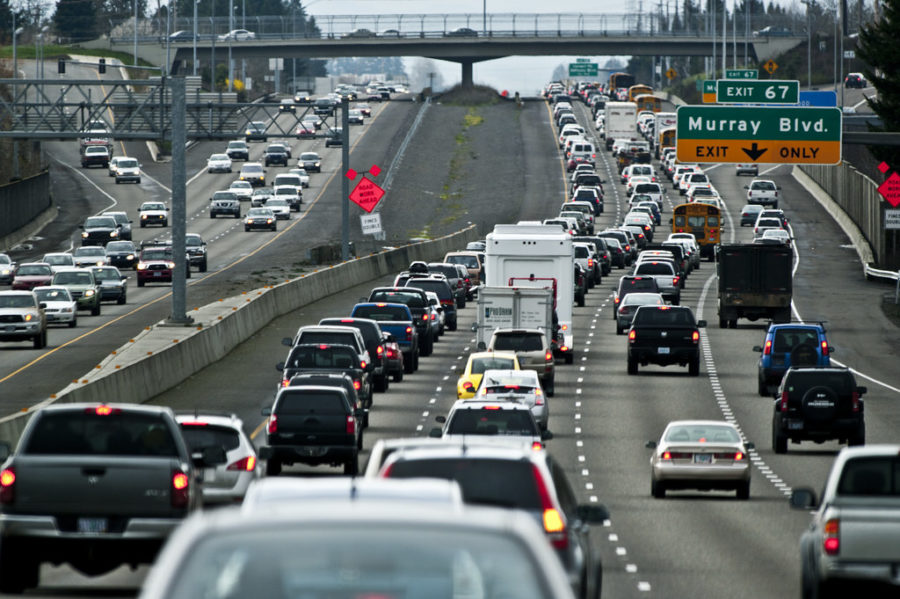What if you had back pain and your doctor told you: “Physical therapy could relieve your pain, and it offers other health benefits. Or you could do a very expensive surgery which comes with additional health risks and, I’m sorry to say, probably won’t help.” Would you:
- Shell out the money to do the surgery first. If it doesn’t work you can always try physical therapy later.
- Try the less expensive physical therapy first. If it doesn’t work, at least you gained the other health benefits and you can always try the surgery later.
- Pay to do the surgery and the physical therapy at the same time.
Obviously option 2, right?
Portland faces a similar challenge. Congestion in the I-5 Rose Quarter Freeway is causing pain for drivers. Taxpayers could try one of the following options to try to reduce drivers’ pain:
- Shell out at least $450 million for a mega freeway expansion. That’s a lot of money, and the project will likely cause other problems like increasing air pollution and climate pollution, and lots of experience (and here and here) says it won’t decrease congestion.
- Try congestion pricing first. It is proven to reduce congestion, it could also reduce pollution, and the region (possibly subject to legal constraints) could use the revenue to give non-drivers more mobility options. Oregon Department of Transportation (ODOT) can still expand the freeway later, but by trying congestion pricing first, it could at least re-size the project to address whatever congestion remains after pricing.
- Pay out the money to expand the freeway, but also try congestion pricing. All the risks and costs of freeway expansion, but with congestion pricing too.
On November 30 (this Thursday!) the Portland City Council will have the opportunity to go on record encouraging ODOT to do option b, try congestion pricing first before throwing away $450 million. But the council might choose option c, thinking it is a safe bet to support congestion pricing but also support the freeway expansion. Option c isn’t a safe bet, it is the worst of both worlds—the big price tag and the extra pollution will outweigh the potential benefits of congestion pricing, possibly generating backlash from drivers who are paying for the expansion through their tax dollars but also paying to drive, and more backlash from non-drivers who are paying for the expansion and the pollution.
There’s real world evidence that shows that road pricing could eliminate the need for billions in highway widenings. Look at Louisville Kentucky, which paid $1 billion to widen I-65 as it crosses the Ohio River (a route very similar to I-5) to reduce congestion. After finishing the project, they started charging drivers $1 to $2; traffic volumes fell by almost half from pre-construction levels. If they’d tolled first, they would have discovered that they didn’t need any additional lanes at all. Choosing option c instead of option b meant the city wasted $1 billion.
A Portland resolution along the lines of option b, urging ODOT to try congestion pricing before expensive expansion would not be out of line with state law. Oregon House Bill 2017 authorized the funds for the Rose Quarter expansion (the state expects to pay $30 million per year from 2022 through 2037 to pay for the megaproject). But the bill also requires the Oregon Transportation Commission to implement value pricing on the I-5 between the Washington state line and its intersection with I-205. The Oregon Transportation Commission must develop a pricing plan and seek federal approval no later than December 31, 2018. The Advisory Committee that will inform ODOT’s feasibility analysis of value pricing met for the first time on November 20.
If Oregon develops a pricing plan in 2018 and receives federal approval in 2019, it could conceivably implement pricing in 2020 and monitor the results before breaking ground on the megaproject. On November 30, the Portland City Council could nudge ODOT in that direction.
[button link='{“url”:”http://www.sightline.org/2017/11/29/faq-about-i-5-rose-quarter-expansion-and-congestion-pricing-in-portland/”,”title”:”Read our Portland congestion pricing FAQ here”}’]


Comments are closed.